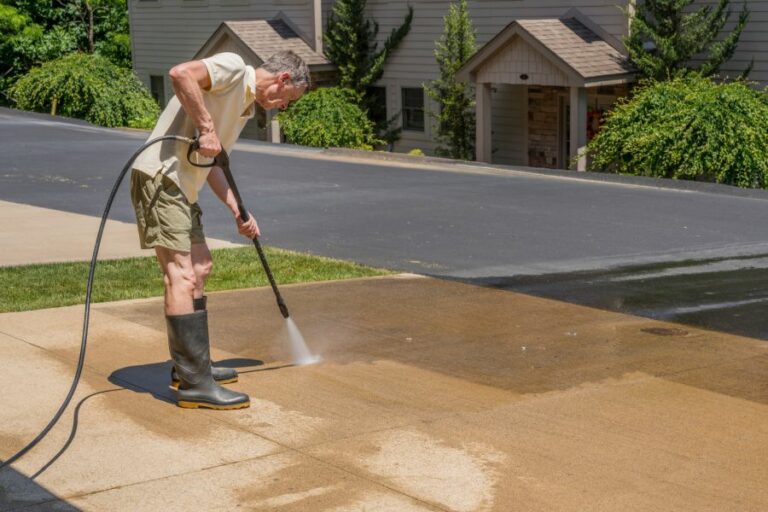Steps For Degreasing Surfaces Before Painting
Are you getting ready to tackle a painting project but find yourself staring at a greasy, grimy surface that needs some attention first? Don’t worry. We’ve got you covered. With the right techniques and materials, degreasing surfaces before painting can be a breeze. Read on to discover the essential steps that will ensure your paint job is pristine and long-lasting!
Steps for degreasing surfaces before painting:
To degrease surfaces before painting, choose the right degreaser based on contamination type and material. Wear personal protective equipment and test the degreaser on a small area. Apply the degreaser, scrub the surface, rinse, and wipe it clean. Let the surface dry and inspect for remaining contamination before proceeding with sanding and priming.

Ready to tackle that painting project? Before you start, it’s crucial to properly degrease surfaces for optimal results. Keep reading as we unveil essential steps to help you achieve a flawless and long-lasting paint job. Don’t miss these expert tips!
Contents
- 1 How to Degrease Surfaces Before Painting
- 1.1 • Why Degreasing Matters
- 1.2 • Step 1: Choose the Right Degreaser
- 1.3 • Step 2: Don Personal Protective Equipment (PPE)
- 1.4 • Step 3: Test the Degreaser on a Small Area
- 1.5 • Step 4: Apply the Degreaser
- 1.6 • Step 5: Scrub the Surface
- 1.7 • Step 6: Rinse and Wipe the Surface
- 1.8 • Step 7: Dry the Surface
- 1.9 • Step 8: Inspect for Remaining Contamination
- 1.10 • Final Thoughts
- 2 Optimal Sequence for Surface Preparation Before Painting
- 2.1 • Step 1: Assess the Surface Condition
- 2.2 • Step 2: Clean the Surface
- 2.3 • Step 3: Repair Damages
- 2.4 • Step 4: Remove Loose Paint
- 2.5 • Step 5: Sand the Surface
- 2.6 • Step 6: Prime the Surface
- 2.7 • Step 7: Mask and Protect Adjacent Areas
- 2.8 • Step 8: Apply the Paint
- 2.9 • Step 9: Clean Up and Dispose of Materials
- 3 Selecting Degreasers for Wood Surfaces Before Painting
- 4 Top Degreasing Methods for Metal Prior to Painting
- 5 Utilizing Degreasers for Paint Preparation: A Guide
How to Degrease Surfaces Before Painting
Proper surface preparation is a vital step in achieving a high-quality and long-lasting paint job. One common challenge is degreasing surfaces before painting. In this article, we’ll discuss the importance of degreasing and provide a step-by-step guide on how to degrease surfaces effectively.
• Why Degreasing Matters
Grease and other contaminants can hinder paint adhesion, leading to a poor and uneven finish. In addition, these contaminants can promote the growth of mold, mildew, and other bacteria, which can cause long-term damage to the painted surface.
By thoroughly degreasing a surface before painting, you can ensure a clean, uniform, and durable paint job.
• Step 1: Choose the Right Degreaser
Selecting the appropriate degreaser is crucial for effective surface preparation. There are several types of degreasers available in the market, and your choice will depend on the type and extent of contamination, as well as the material you are cleaning.
Water-based degreasers are suitable for light to medium contamination, while solvent-based degreasers, such as mineral spirits and denatured alcohol, are better suited for heavy grease and oil removal.
The Environmental Protection Agency (EPA) provides a list of safer alternative degreasers that are effective and have a reduced environmental impact.
• Step 2: Don Personal Protective Equipment (PPE)
When working with degreasers, it’s essential to wear appropriate PPE to protect yourself from potentially harmful chemicals. This may include gloves, goggles, and a face mask. Additionally, work in a well-ventilated area to minimize the risk of inhaling harmful fumes.
• Step 3: Test the Degreaser on a Small Area
Before applying the degreaser to the entire surface, test it on a small, inconspicuous area to ensure compatibility with the material and to check for any adverse reactions. If the degreaser causes damage or discoloration, consider using a different product.
• Step 4: Apply the Degreaser
For water-based degreasers, dilute the product according to the manufacturer’s instructions. Apply the solution to the surface using a cloth, sponge, or spray bottle. For solvent-based degreasers, apply the product directly to a cloth or sponge and gently rub it onto the surface.
When degreasing large areas, work in small sections to avoid allowing the degreaser to dry on the surface. This will ensure it’s easier to remove the contaminants in the next step.
• Step 5: Scrub the Surface
Use a scrub brush or sponge to gently agitate the surface, working the degreaser into the dirt and grease. For heavily soiled surfaces, you may need to apply an additional degreaser and repeat this step.
• Step 6: Rinse and Wipe the Surface
After the grease has been loosened from the surface, it’s essential to remove the degreaser along with the contaminants.
Use a clean, damp cloth or sponge to wipe off the degreaser, ensuring that no residue is left behind. If necessary, rinse the surface with clean water to remove any remaining traces of the degreaser.
• Step 7: Dry the Surface
Allow the surface to dry completely before painting to prevent moisture-related problems, such as peeling and bubbling. Depending on the material and weather conditions, this may take several hours or even days. You can use fans or heaters to speed up the drying process.
• Step 8: Inspect for Remaining Contamination
After the surface is dry, inspect it for any remaining grease or soiling. If any contaminant remains, you may need to repeat the degreasing process. Once the surface is clean and free of grease, you’re ready to proceed with further surface preparation, such as sanding and priming, before painting.
• Final Thoughts
Degreasing surfaces before painting is an essential step in achieving a professional-looking and long-lasting paint job. By following these steps and using the right products, you can ensure a clean, contaminant-free surface that will improve paint adhesion and extend the life of your paint job.
Optimal Sequence for Surface Preparation Before Painting
• Step 1: Assess the Surface Condition
The first step in preparing a surface for painting is to assess its current state. This will help you determine the necessary steps and procedures required to achieve a clean and smooth surface for painting. Look for any signs of damage, such as cracks, holes, and peeling paint.
Make sure to also check for mold and mildew, as these can have negative effects on the paint’s adhesion and overall quality.
• Step 2: Clean the Surface
Before you can begin any repairs or preparations, it is important to clean the surface thoroughly. Dirt, dust, and grime can affect the paint’s adhesion, leading to a poor-quality finish.
You can use a mild detergent or a specialized cleaning solution, such as trisodium phosphate (TSP), to clean the surface. Rinse thoroughly with water and allow the surface to dry completely before proceeding.
• Step 3: Repair Damages
After the surface is clean and dry, you can begin repairing any damages. Fill any holes and cracks with an appropriate filler, such as wood filler or joint compound. Allow the filler to dry, and then sand it down using fine-grit sandpaper to create a smooth and even surface.
For severe damages, replacement of the affected area may be necessary for structural integrity and to maintain the appearance of the surface.
• Step 4: Remove Loose Paint
For surfaces previously painted or with peeling paint, removing the loose paint is essential for proper adhesion of the new paint. Use a paint scraper or a wire brush to remove the loose paint. Be cautious not to damage the surface in the process.
If dealing with extensive peeling paint, a pressure washer may expedite the process.
• Step 5: Sand the Surface
Sanding helps create a smooth and even surface for the paint to adhere to. Using fine-grit sandpaper, lightly sand the entire surface to remove any remaining debris, loose paint, or glossy surfaces. Wipe the surface with a damp cloth to remove any sanding dust.
• Step 6: Prime the Surface
Priming is an essential step, especially when dealing with surfaces that have never been painted before, have significant color changes, or have repairs. Primer serves as a base coat that improves paint adhesion, enhances paint durability, and ensures an even finish.
Use a quality primer that is compatible with the paint you have selected, and follow the manufacturer’s instructions for application. Allow the primer to dry completely before moving on to the next step.
• Step 7: Mask and Protect Adjacent Areas
To prevent paint from getting on unwanted areas, mask off adjacent surfaces with painter’s tape. Make sure that the tape is firmly pressed down to minimize paint seeping under the tape. Also, consider using drop cloths or plastic sheeting to protect the surrounding floors and furniture.
• Step 8: Apply the Paint
Finally, it’s time to apply the paint. Use high-quality brushes or rollers to ensure a smooth and even application. Start by cutting in the edges and corners with a brush, followed by rolling the paint onto larger areas.
Apply the paint in thin, even coats, allowing each coat to dry fully before applying the next. It is recommended to apply at least two coats for a durable and long-lasting finish.
• Step 9: Clean Up and Dispose of Materials
Once the paint is dry and the job is complete, remove the painter’s tape and drop cloths. Properly dispose of any used paint, brushes, rollers, and other materials according to your local waste disposal guidelines.
By following these steps, you can ensure a successful painting project that achieves a beautiful and durable finish. Good preparation is key to quality results, so take the time to properly assess, clean, and repair the surface to be painted, ensuring a smooth and even surface to work with.
With the right tools, techniques, and patience, you’ll achieve a professional-looking result that you can be proud of.
Selecting Degreasers for Wood Surfaces Before Painting
One of the crucial steps in the painting process, whether you’re dealing with furniture, cabinetry, or other wood items, is to ensure that the surface is clean and free of grease or dirt.
Degreasing wood prior to painting is essential to help the paint adhere properly and ensure a successful, long-lasting finish. This article will offer suggestions on how to degrease wood effectively using different methods, so you can make an informed decision based on your project requirements and preferences.
• Why Degreasing Matters: A Word on Common Issues
Before diving into the different degreasing methods, it’s essential to understand why removing grease from wood is vital. Paint cannot adhere to surfaces covered in grease, oils, or dirt, which leads to bubbling, peeling, or flaking issues post-painting.
Moreover, grease can react negatively with certain paint types, causing discoloration and even affecting the paint’s durability. By ensuring the wood surface is adequately degreased, you are setting the foundation for a smoother, lasting finish.
• The Right Tools for Degreasing Wood
The following are the tools that you’ll need to carry out the degreasing process effectively:
- A mild detergent or a degreasing solution specifically designed for wood surfaces
- Soft cloths, sponges, or brushes for cleaning
- Warm water
- Protective gloves
- Clean, dry cloth or paper towels for wiping away residue
- Sanding equipment (optional)
• Method 1: Using a Mild Detergent
A simple and cost-effective method for degreasing wood involves using a mild detergent, such as dish soap, combined with warm water. This method is suitable for most wood surfaces, although it might not be the best option for heavily soiled areas.
To use this method, mix a few drops of mild detergent with warm water in a bucket. Then, dip a soft cloth, sponge, or brush into the solution and scrub the wood surface gently, paying particular attention to any crevices or corners.
Once the surface is cleaned, rinse it with clean, warm water, and use a clean, dry cloth or paper towel to remove any remaining residue.
• Method 2: Using a Wood-Specific Degreaser
For more stubborn grease or large projects, consider using a commercial degreaser specifically designed for wood surfaces. These degreasers, such as Krud Kutter Prepaint Cleaner, are stronger than mild detergents, making them suitable for removing oil, grime, and even old paint.
Be sure to follow the manufacturer’s instructions for the correct dilution and application.
As with the detergent method, apply the degreasing solution to the wood surface using a soft cloth, sponge, or brush, then rinse the area thoroughly with clean, warm water. Remember to wear protective gloves while using commercial degreasers, as they may be harsh on your skin.
• Method 3: Utilize a Water-Based Solvent
Some types of wood projects may require a more potent degreasing solution, like a water-based solvent. For example, if you’re preparing a hardwood surface or dealing with heavy grease buildup, the water-based solvent TSP (Trisodium Phosphate) can be an effective option.
TSP is an all-purpose, heavy-duty cleaner that effectively removes grease, dirt, and stains from various surfaces.
To use TSP as a degreaser, mix it with warm water, following the manufacturer’s instructions for the appropriate ratio. Apply the solution to the wood surface using a cloth, sponge, or brush, then rinse with clean, warm water, and dry the surface using a clean cloth or paper towel.
• Additional Tips: Sanding and Safe Practices
After degreasing the wood surface, you may want to consider sanding it to create a smoother, more receptive finish for the paint. Sanding can also help remove any residue or stubborn grease that may still be present.
Always wear protective gloves while using chemical degreasers or solvents, and be sure to work in a well-ventilated area to minimize the risk of exposure to harmful fumes.
• Conclusion
Degreasing is a crucial step in preparing a wood surface for painting. By choosing the right method and following proper procedures, you’ll ensure that your paint project is successful, long-lasting, and visually appealing.
Use mild detergents for small, lightly soiled projects, and turn to commercial degreasers or water-based solvents for more challenging situations. Remember to work safely, wear proper protective gear, and always follow the manufacturer’s guidelines for your chosen products.
Top Degreasing Methods for Metal Prior to Painting
Proper surface preparation is essential when it comes to painting metal surfaces. One of the most critical steps is removing grease, oil, and dirt that accumulated over time.
Failure to properly degrease metal surfaces can hamper paint adhesion, leading to poor and short-lived results. In this comprehensive article, we’ll cover the best methods to degrease metal before painting.
• The Importance of Degreasing Metal Surfaces
Before diving into the best degreasing methods, it is crucial to understand why degreasing is necessary. Grease, oil, and dirt can act as barriers between the paint and the metal surface, preventing a secure bond and leading to peeling, chipping, or blistering.
Moreover, metal surfaces are prone to corrosion and rust, which can be exacerbated by trapped grease and dirt. Adequate degreasing not only ensures proper paint adhesion but also protects the metal from further damage.
• Aqueous Cleaners: Effective and Environmentally Friendly
Aqueous cleaners are water-based solutions that are an effective and eco-friendly choice for degreasing metal surfaces. These cleaners often contain various alkaline compounds that can break down and lift grease from the metal surface. They come in different types, such as:
- Alkaline Cleaners: Perfect for removing heavy-duty grease, oils, and contaminants.
- Mild Alkaline Cleaners: Suited for removing light to medium oils and grease.
I recommend starting with a mild solution before moving on to a more aggressive cleaner if necessary. To use aqueous cleaners, follow these steps:
- Dilute the cleaner with water according to the manufacturer’s instructions.
- Apply the solution to the metal surface using a brush or spray.
- Allow it to sit for a few minutes, then scrub the surface with a stiff brush.
- Rinse thoroughly with water.
- Allow the surface to dry properly before proceeding to the painting step.
• Solvent Degreasers: Quick and Efficient
Solvent-based degreasers are popular for their ability to remove grease, oil, and dirt quickly and efficiently. Some common solvents include:
- Acetone
- Isopropyl Alcohol
- Mineral Spirits
- Denatured Alcohol
These solvents can effectively break down and dissolve grease and oil, making them an excellent choice for heavy-duty degreasing tasks. However, it is essential to work in a well-ventilated area and use personal protective equipment (such as gloves and goggles) due to the dangerous fumes they emit.
To use a solvent-based degreaser, follow these steps:
- Soak a clean, lint-free cloth with the solvent.
- Wipe down the surface, applying moderate pressure to remove the grease and contaminants.
- Use a clean, dry cloth to remove any residue or remaining traces of the solvent.
- Allow the surface to dry before painting.
• Brushes and Abrasives: Mechanical Degreasing
Mechanical degreasing methods utilize brushes, sandpaper, or steel wool to remove grease and contaminants from metal surfaces.
In some instances, like removing tough or caked-on grease, this can be the most efficient method. It is essential to use an appropriate abrasive, depending on the hardness and surface condition of the metal, to avoid damaging it.
To perform mechanical degreasing, follow these steps:
- Choose the appropriate abrasive material.
- Use a brush or abrasive pad to scrub the surface.
- Vacuum, brush or wipe away the debris and dust.
- Follow up with an aqueous cleaner or solvent if necessary.
• Expert Tips for Effective Degreasing
- Always start with the least aggressive method and gradually work your way up if required.
- Assess the condition of the metal surface and choose the right degreasing method accordingly.
- Do not forget to rinse the surface thoroughly after using aqueous cleaners; residues from the cleaner can also cause adhesion issues.
- Wear appropriate personal protective equipment, especially when handling solvents.
- Consult reliable sources, like the EPA’s guide on cleaning and degreasing best practices, to ensure you are using environmentally friendly and safe cleaning methods.
Taking the time to properly degrease metal surfaces before painting is crucial for achieving a durable and professional finish. By using the methods and tips provided in this article, you can ensure successful results on your next metal painting project.
Material | Degreasing Agent |
|---|---|
Metal | Acetone or paint thinner |
Utilizing Degreasers for Paint Preparation: A Guide
The purpose of this article is to provide an in-depth guide on whether or not it is appropriate to use degreaser to prep surfaces for paint. We will discuss the various factors to consider, some alternative methods, and practical advice on how to achieve the best results in your painting project.
• Why Use Degreaser in the First Place?
Before diving into the question of whether degreaser can be used to prep for paint, it’s important to understand why one would consider using degreaser in the first place.
The primary function of a degreaser is to remove contaminants, such as grease, oil, and dirt, from surfaces to ensure proper adhesion of paint, primer, or other coatings.
In many cases, these contaminants can prevent paint from adhering properly, resulting in an uneven finish or peeling paint over time. Therefore, it is crucial to ensure that surfaces are clean and free of contaminants before applying paint.
• The Role of Degreaser in Paint Preparation
Using a degreaser to prep for paint can be an effective method for achieving a clean surface, as long as the appropriate degreaser products are used and proper techniques are followed.
It is important to note that not all degreasers are created equal, and some may not be suitable for use on certain surfaces or with specific types of paint.
I recommend using degreasers specifically formulated for paint preparation to ensure optimal results. These products are designed to remove contaminants without leaving behind any residue that could negatively affect paint adhesion.
Be sure to examine the product label carefully, as some degreasers may not be suitable for use on specific surfaces, such as aluminum or plastic.
• How to Properly Use Degreaser for Paint Prep
To use a degreaser effectively and safely, follow these best practices:
- Safety first: Always wear gloves, safety goggles, and a mask when working with degreasers to protect your skin, eyes, and lungs from potential irritation or harm.
- Choose the right product: Select a degreaser specifically formulated for paint preparation and suitable for the surface you will be cleaning.
- Test a small area: Before applying the degreaser to the entire surface, perform a patch test on a small, inconspicuous area to ensure the product will not damage the surface or react adversely with the paint.
- Follow manufacturer instructions: Adhere strictly to the application and safety guidelines provided by the degreaser manufacturer. This includes the recommended dwell time, which is the duration the degreaser should sit on the surface before being wiped or rinsed away.
- Wipe or rinse thoroughly: After the degreaser has had sufficient time to work, remove it completely by wiping it away with a clean cloth or rinsing it with water, depending on the manufacturer’s instructions. Ensure no residue is left behind, as this can interfere with paint adhesion.
- Allow the surface to dry: Before applying paint or primer, allow the surface to dry fully to avoid trapping moisture beneath the paint, which can lead to peeling or bubbling.
• Alternative Methods for Paint Prep
While using degreaser can be an effective method for paint prep, there are alternative options available to ensure a clean, well-prepared surface:
- Soap and water: For lightly soiled surfaces, a thorough cleaning with mild dish soap and warm water can remove general dirt and grime. Be sure to rinse thoroughly and allow the surface to dry completely.
- TSP (Trisodium phosphate): TSP is a versatile, heavy-duty cleaner that works well to remove contaminants and prepare surfaces for painting. Always follow the manufacturer’s instructions, wear appropriate safety gear, and rinse the surface thoroughly after using TSP.
- Sanding or abrasive pads: For surfaces with existing paint or coatings, sanding or using an abrasive pad can remove loose or peeling paint and provide a smooth surface for the new paint to adhere. Be sure to wipe or vacuum away any dust created during this process.
• In Conclusion
Using a degreaser can be an effective solution for preparing surfaces for paint, ensuring contaminants are removed, and providing a suitable surface for proper paint adhesion.
It is essential to choose the right degreaser for the specific surface and type of paint, follow manufacturer instructions, and rinse the surface thoroughly to achieve the best results.
However, alternative methods such as soap and water, TSP, or sanding may also be suitable, depending on the needs of your specific painting project.
Using Degreaser | Prepping for Paint |
|---|---|
Yes, you can use degreaser to clean surfaces before painting. | It helps to remove grease, dirt, and any contaminants that can affect paint adhesion. |
Make sure to rinse the surface thoroughly after using the degreaser. | Use clean water and allow the surface to dry completely before applying any paint. |
Follow the manufacturer’s instructions for proper application and dilution of the degreaser. | Always work in a well-ventilated area and wear appropriate safety gear, such as gloves and eye protection. |







